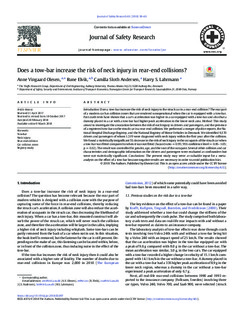| dc.contributor.author | Olesen, Anne Vingaard | |
| dc.contributor.author | Elvik, Rune | |
| dc.contributor.author | Andersen, C.S. | |
| dc.contributor.author | Lahrmann, H. | |
| dc.coverage.spatial | Denmark | nb_NO |
| dc.date.accessioned | 2019-12-18T13:56:11Z | |
| dc.date.available | 2019-12-18T13:56:11Z | |
| dc.date.created | 2018-03-26T13:53:24Z | |
| dc.date.issued | 2018-03-09 | |
| dc.identifier.citation | Journal of Safety Research. 2018, 65 (June), 59-65. | nb_NO |
| dc.identifier.issn | 0022-4375 | |
| dc.identifier.uri | http://hdl.handle.net/11250/2633987 | |
| dc.description.abstract | Does a tow-bar increase the risk of neck injury in the struck car in a rear-end collision? The rear part of a modern car has collision zones that are rendered nonoperational when the car is equipped with a tow-bar. Past crash tests have shown that a car's acceleration was higher in a car equipped with a tow-bar and also that a dummy placed in a car with a tow-bar had higher peak acceleration in the lower neck area. Method This study aimed to investigate the association between the risk of neck injury in drivers and passengers, and the presence of a registered tow-bar on the struck car in a rear-end collision. We performed a merger of police reports, the National Hospital Discharge Registry, and the National Registry of Motor Vehicles in Denmark. We identified 9,370 drivers and passengers of whom 1,519 were diagnosed with neck injury within the first year after the collision. We found a statistically insignificant 5% decrease in the risk of neck injury in the occupants of the struck car when a tow-bar was fitted compared to when it was not fitted (hazard ratio = 0.95; 95% confidence level = 0.85–1.05; p = 0.32). The result was controlled for gender, age, and the seat of the occupant. Several other collision and car characteristics and demographic information on the drivers and passengers were evaluated as confounders but were not statistically significant. Conclusions The present study may serve as valuable input for a meta-analysis on the effect of a tow-bar because negative results are necessary in order to avoid publication bias. | nb_NO |
| dc.language.iso | eng | nb_NO |
| dc.rights | Navngivelse 4.0 Internasjonal | * |
| dc.rights.uri | http://creativecommons.org/licenses/by/4.0/deed.no | * |
| dc.title | Does a tow-bar increase the risk of neck injury in rear-end collisions? | nb_NO |
| dc.type | Journal article | nb_NO |
| dc.type | Peer reviewed | nb_NO |
| dc.rights.holder | © 2018 The Authors. Published by Elsevier Ltd. | nb_NO |
| dc.description.version | publishedVersion | nb_NO |
| cristin.unitcode | 7482,2,1,0 | |
| cristin.unitname | Sikkerhet og tiltak | |
| cristin.ispublished | true | |
| cristin.fulltext | original | |
| cristin.qualitycode | 1 | |
| dc.identifier.doi | 10.1016/j.jsr.2018.02.007 | |
| dc.identifier.cristin | 1575767 | |
| dc.source.journal | Journal of Safety Research | nb_NO |
| dc.source.volume | 65 | nb_NO |
| dc.source.issue | June | nb_NO |
| dc.source.pagenumber | 59-65 | nb_NO |

